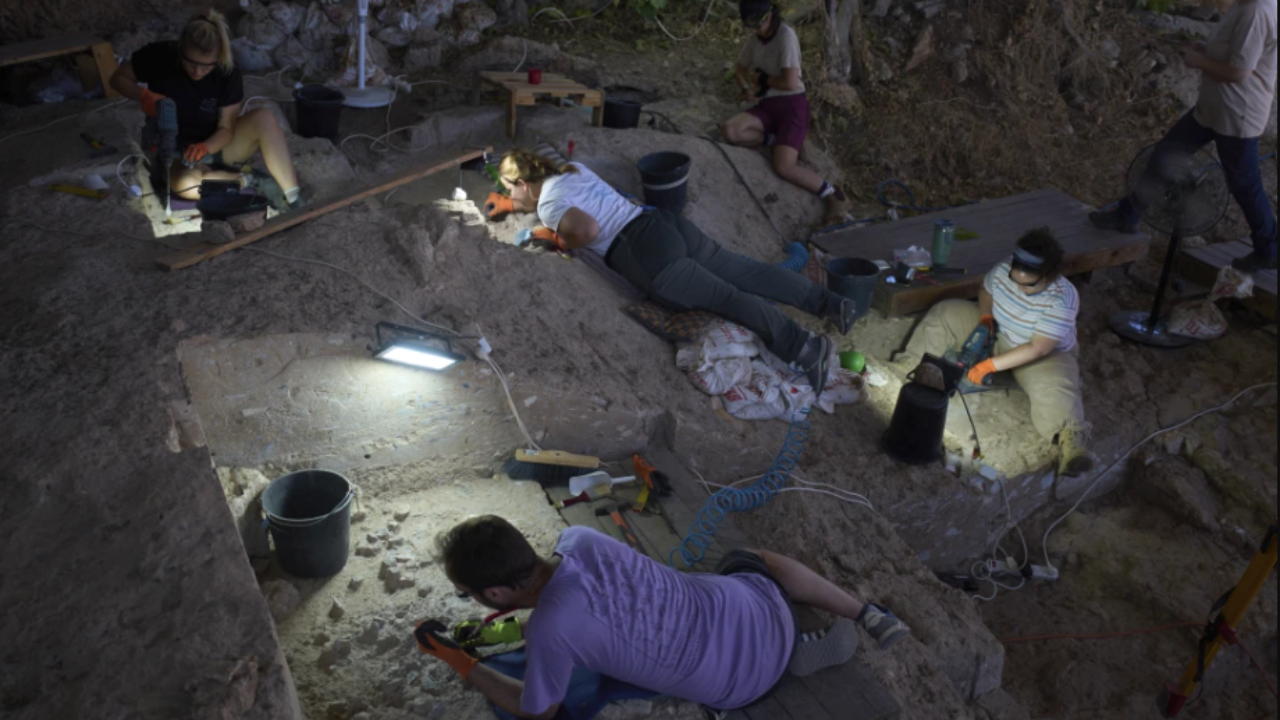
©(AP Photo by Ariel Schalit)
Vocabulary:
I will read the words, meanings, and sample sentences. Then, repeat after me.
- burial /BER-ee-uhl/
- pose /pohz/
- ochre /OH-ker/
- emergence /ih-MUR-juhns/
- territorial /ter-i-TAWR-ee-uhl/
[noun] – the act or ceremony of placing a dead body into the ground
The ancient tribe had a special burial ground near the mountains.
[noun] – a specific position of the body, especially when arranged deliberately
The model sat in a relaxed pose for the painting session.
[noun] – a natural earth pigment containing iron, used for coloring in art and decoration
Artists in ancient Rome often used ochre to paint walls and pottery.
[noun] – the process of becoming visible, known, or important
The emergence of new technology changed the way people communicate.
[adjective] – relating to the ownership or control of land or area
The two countries had a territorial dispute over the island.
Article reading:
Please read the whole article. Then, I will check your pronunciation and intonation.
In central Israel, archaeologists have uncovered a prehistoric burial site in Tinshemet Cave, believed to be one of the oldest in the world. The site contains well-preserved remains of early humans, dating back around 100,000 years. This discovery, published in Nature Human Behavior in March 2025, offers new evidence about how early humans treated their dead. The skeletons were found in pits, positioned carefully in a burial pose, and were surrounded by items such as basalt stones, animal bones, and ochre pigment. Experts believe these objects were used in ceremonial rituals, possibly to honor the deceased. This supports the theory that early humans had complex beliefs about spirituality and life after death.
Archaeologists have been working at the site since 2016, using precise tools to carefully remove bones and artifacts. Two complete skeletons and several skulls were discovered, along with over 500 fragments of colored ochre. The ash from ancient fires, mixed with local limestone and rainfall, helped preserve these items in exceptional condition. Experts say this level of preservation is rare and important for studying ancient human behavior. The findings are comparable to earlier discoveries in Skhul and Qafzeh Caves in northern Israel but are considered more reliable due to modern excavation methods. The site may also reveal interactions between Neanderthals and Homo sapiens in the region. Researchers believe the burial practices represent a significant transformation in early human society, suggesting the emergence of symbolic thinking and territorial claims.
Archaeologists have been working at the site since 2016, using precise tools to carefully remove bones and artifacts. Two complete skeletons and several skulls were discovered, along with over 500 fragments of colored ochre. The ash from ancient fires, mixed with local limestone and rainfall, helped preserve these items in exceptional condition. Experts say this level of preservation is rare and important for studying ancient human behavior. The findings are comparable to earlier discoveries in Skhul and Qafzeh Caves in northern Israel but are considered more reliable due to modern excavation methods. The site may also reveal interactions between Neanderthals and Homo sapiens in the region. Researchers believe the burial practices represent a significant transformation in early human society, suggesting the emergence of symbolic thinking and territorial claims.
Discussion Questions:
I will read each question. Then, please answer them.
- Have you ever visited a museum or historical site? If so, what did you find most interesting there? If not, would you like to visit one in the future? Why or why not?
- Have you learned about ancient humans or archaeology in school? If so, what do you remember learning? If not, would you like to learn more about early human life? Why or why not?
- Do you agree that studying ancient burial sites can help people understand early human life?
- How do burial practices from the past compare to burial practices in the world today?
- Why do you think early humans traveled far to bring special stones or pigments to the cave?
Summarization
Please summarize the whole article using your own words and expressions. You will have one minute to prepare before you answer.
Describe:
Please explain the definition of each word listed below based on your understanding. You can provide example sentences if needed.
- archaeologist
- well-preserved
- evidence
- complex belief
- behavior